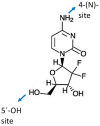Pancreatic Cancer Chemoresistance to Gemcitabine
- PMID: 29144412
- PMCID: PMC5704175
- DOI: 10.3390/cancers9110157
Pancreatic Cancer Chemoresistance to Gemcitabine
Abstract
Pancreatic ductal adenocarcinoma (PDAC), commonly referred to as pancreatic cancer, ranks among the leading causes of cancer-related deaths in the Western world due to disease presentation at an advanced stage, early metastasis and generally a very limited response to chemotherapy or radiotherapy. Gemcitabine remains a cornerstone of PDAC treatment in all stages of the disease despite suboptimal clinical effects primarily caused by molecular mechanisms limiting its cellular uptake and activation and overall efficacy, as well as the development of chemoresistance within weeks of treatment initiation. To circumvent gemcitabine resistance in PDAC, several novel therapeutic approaches, including chemical modifications of the gemcitabine molecule generating numerous new prodrugs, as well as new entrapment designs of gemcitabine in colloidal systems such as nanoparticles and liposomes, are currently being investigated. Many of these approaches are reported to be more efficient than the parent gemcitabine molecule when tested in cellular systems and in vivo in murine tumor model systems; however, although promising, their translation to clinical use is still in a very early phase. This review discusses gemcitabine metabolism, activation and chemoresistance entities in the gemcitabine cytotoxicity pathway and provides an overview of approaches to override chemoresistance in pancreatic cancer.
Keywords: chemoresistance; gemcitabine; pancreatic ductal adenocarcinoma; tumor stroma.
Conflict of interest statement
The authors declare no conflict of interest.
Figures



References
-
- American Cancer Society Key Statistics for Pancreatic Cancer. [(accessed on 1 October 2017)]; Available online: https://www.cancer.org/cancer/pancreatic-cancer/about/key-statistics.html.
-
- Seer Cancer Stat Facts: Pancreas Cancer. [(accessed on 1 October 2017)]; Available online: https://seer.cancer.gov/statfacts/html/pancreas.html.
Publication types
LinkOut - more resources
Full Text Sources
Other Literature Sources

